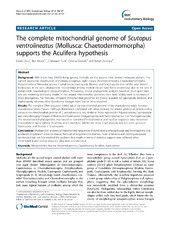| dc.description.abstract | Background: With more than 100000 living species, mollusks are the second most diverse metazoan phylum. The current taxonomic classification of mollusks recognizes eight classes (Neomeniomorpha, Chaetodermomorpha, Polyplacophora, Monoplacophora, Cephalopoda, Gastropoda, Bivalvia, and Scaphopoda) that exhibit very distinct body plans. In the past, phylogenetic relationships among mollusk classes have been contentious due to the lack of indisputable morphological synapomorphies. Fortunately, recent phylogenetic analyses based on multi-gene data sets are rendering promising results. In this regard, mitochondrial genomes have been widely used to reconstruct deep phylogenies. For mollusks, complete mitochondrial genomes are mostly available for gastropods, bivalves, and cephalopods, whereas other less-diverse lineages have few or none reported. Results: The complete DNA sequence (14662 bp) of the mitochondrial genome of the chaetodermomorph Scutopus ventrolineatus Salvini-Plawen, 1968 was determined. Compared with other mollusks, the relative position of protein-coding genes in the mitochondrial genome of S. ventrolineatus is very similar to those reported for Polyplacophora, Cephalopoda and early-diverging lineages of Bivalvia and Gastropoda (Vetigastropoda and Neritimorpha; but not Patellogastropoda). The reconstructed phylogenetic tree based on combined mitochondrial and nuclear sequence data recovered monophyletic Aplacophora, Aculifera, and Conchifera. Within the latter, Cephalopoda was the sister group of Gastropoda and Bivalvia + Scaphopoda. Conclusions: Phylogenetic analyses of mitochondrial sequences showed strong among-lineage rate heterogeneity that produced long-branch attraction biases. Removal of long branches (namely those of bivalves and patellogastropods) ameliorated but not fully resolved the problem. Best results in terms of statistical support were achieved when mitochondrial and nuclear sequence data were concatenated. | en_US |

